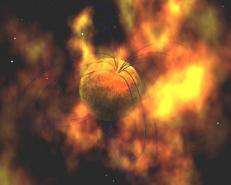Astronomers Pinpoint Origin of Nature's Most Powerful Magnetic Bursts

University of Arizona astronomers have pinpointed the origin of powerful bursts from nature's most magnetic objects. The bursts are from "magnetars," some of the most enigmatic objects in the universe.
Magnetars are a type of neutron star, which are superdense stars that pack the mass of a sun into a body the size of Manhattan Island. Tiny magnetars possess magnetic fields that are at least 100 trillion times as powerful as Earth's magnetic field. They occasionally produce powerful bursts, hurling high-energy radiation cascading across space. The origin of these energetic eruptions and the strong magnetic fields is a mystery.
Astronomers discovered a magnetar with the NASA's X-Ray Timing Explorer in July 2003, when it brightened by about 100 times its usual faint luminosity. They continued monitoring it regularly with the European Photon Imaging Camera, known as EPIC, on the European Space Agency's XMM-Newton Observatory until March 2006, when the object faded to its pre-outburst brightness.
As the magnetar faded, EPIC recorded changes in the energies of the X-rays released.
Tolga Guver, who is a visiting graduate student at the UA, working with Assistant Professor Feryal Ozel of the UA physics and UA astronomy departments, compared the magnetar's changing X-ray spectrum with predictions from a computer model. They developed the model to describe the physical properties of a magnetar's surface and magnetic field in detail.
Guver, Ozel and their collaborators found that the data was best fitted with a model that traced the outburst to just below the surface of the magnetar and confined it to an area about 3.5 kilometers (about two miles) across.
"This is the first time both the surface emission and its subsequent reprocessing in the magnetosphere have been incorporated into the same computer model," Ozel said.
"This is a breakthrough because we can now distinguish between surface and magnetospheric phenomena,'' Guver said.
Determining both the size and the location of the powerful burst is like "performing anatomy on a distant, tiny star,'' Ozel added.
Their model also allowed Guver, Ozel and their colleagues to determine spectroscopically the strength of this object's magnetic field. The magnetar's magnetic field is around 600 trillion times stronger than the Earth's magnetic field.
The scientists say they are encouraged because the measurement is similar to an earlier estimate made based on how fast the source is "spinning down," which is the change in the spin period over time. They said it boosts their confidence that their model is correct.
"It is tremendously exciting to be able to compute exotic quantum phenomena that appear only in these ultrastrong magnetic fields and to see these predictions appear in actual data,'' Ozel added.
The astronomers say that they don't yet understand the mechanism of the outburst, which is probably somehow magnetically triggered.
The researchers say they plan to use their computer model to study more magnetars, using more data from X-ray observatories, in the quest for answers.
They are publishing their results in today's edition (Sept. 20, 2007) of the Astrophysical Journal Letters. The paper's authors are Guver, Ozel, Ersin Gogus of Sabanci University, Istanbul, Turkey, and Chryssa Kouveliotou of the NASA Marshall Space Flight Center, Huntsville, Ala.
Source: University of Arizona





















